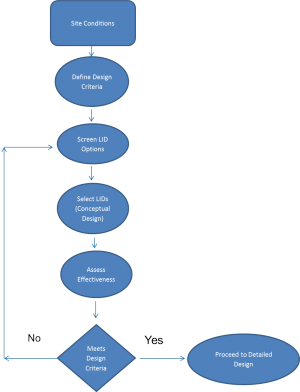Screening LID options
Process for selecting a suite of LID Options[edit]
Site Conditions[edit]
Complete definition of pre-development site conditions is essential prior to screening of
potential stormwater BMPs. The designer should prepare maps describing site
conditions, to ensure that all environmental features and functions that need
consideration in accordance with provincial, municipal and conservation authority
development regulations are identified. This includes watercourses and small drainage
features, floodplains, important recharge areas, steep slopes, wetlands, natural heritage
conservation areas and significant wildlife habitats. In addition, information regarding
native soil types, infiltration capacity and depth to water table must be determined.
Define Design Criteria[edit]
A detailed description of the design criteria that need to be defined is provided in the
respective CVC and TRCA Stormwater Management Criteria documents. If outside jurisdictional
boundaries, criteria developed should have requirements to:
- preserve groundwater and baseflow characteristics;
- prevent undesirable and costly geomorphic changes in the watercourse;
- prevent any increases in flood risk potential;
- protect water quality; and ultimately,
- maintain an appropriate diversity of aquatic life and opportunities for human uses
The design criteria required to protect, enhance or restore the environmental resources
can be grouped under the following five categories.
- Flood Protection;
- Water Quality;
- Erosion Control;
- Recharge; and
- Natural Heritage Systems or green infrastructure
Screen Potential LID Options[edit]
A number of factors need to be considered when screening the suitability of a given
location within a development site for application of stormwater BMPs. Table 3.4.1
summarizes site constraints associated with some general types of structural LID
practices for stormwater management that should be considered. Further
information regarding constraints to the design of various end-of-pipe BMPs can be
found in the Ontario Ministry of the Environment Stormwater Management Planning and
Design Manual (2003). The use of LID BMPs should be considered first to meet the
design criteria before the use of end-of-pipe BMPs.
Structural Requirements or Site Constraints[edit]
Performance Requirements[edit]
Operations and Maintenance Requirements[edit]
Life Cycle Costing Requirements[edit]
Select LIDs (Conceptual Design)[edit]
In order to assess if the selected suite of BMPs effectively meet the design criteria
either computer models or simple spreadsheet models should be used. Model selection
will be based on the size and type of development. A wide range of simple to complex
computer models such as Visual OTTHYMO, SWMM, SWMMHYNO, HSP-F and
QUALHYMO are available.
Assess Effectiveness[edit]
Once the suite of best management practices have been selected and the models have
been run, a comparison of the results and the environmental design criteria can be
made. An iterative approach, which involves adjusting the size or adding/deleting BMPs
should be used until the environmental design criteria are met. The project can then
proceed to the detailed design stage.
